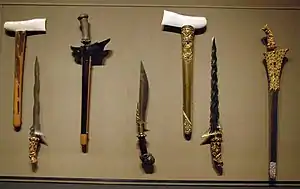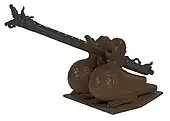| Bara Sangihe | |
|---|---|
 A Bara Sangihe sword, 1925. | |
| Type | Sword |
| Place of origin | Indonesia (North Sulawesi) |
| Service history | |
| Used by | Sangirese people |
| Specifications | |
| Length | overall length: approx. 100–150 cm (39–59 in) |
| Blade type | Split-tip single edged |
| Hilt type | Wood |
The Bara Sangihe (or as it is also known locally as Pedang Bara Sangihe) sword originates from North Sulawesi, Indonesia.
Background
The word bara means "sword" in Sangirese language,[1] therefore it literally means "Sangirese sword". The Bara Sangihe is known for its unique shaped blade that resembles a crocodile[2] or a beak of a bird with serrations. The shape of its handle also splits into two,[3] is made of wood, carved with traditional Sangirese motifs.[4] It is also said that the Bara Sangihe is one of the weapons used by a local warrior from North Sulawesi, Hengkeng U Nang, born in 1590.[5]
See also
References
- ↑ "Proyek Inventarisasi dan Dokumentasi Kebudayaan Daerah (Indonesia)". Adat istiadat daerah Sulawesi Utara. Departemen Pendidikan dan Kebudayaan, Proyek Inventarisasi dan Dokumentasi Kebudayaan Daerah. 1983. p. 191. OCLC 14233056.
- ↑ Dwi Fajar Sejati (2022). Dini & Sigit (ed.). TOP MASTER RPUL untuk SD/MI Kelas 4, 5, & 6. Bmedia. p. 127.
- ↑ Afdal Hasan (13 July 2023). "Mengagumi 4 Senjata Tradisional Sulawesi Utara, Konon Sudah Ada 5.000 Tahun Silam". Good News From Indonesia. Archived from the original on 11 November 2023. Retrieved 11 November 2023.
- ↑ "Kehebatan Pedang Bara Sangihe dari Sulawesi Utara". Indonesia Kaya. Archived from the original on 11 November 2023. Retrieved 11 November 2023.
- ↑ Dian Kristiani (2019). 365 HARI KELILING NUSANTARA. BIP (Bhuana Ilmu Populer). p. 326. ISBN 978-62-321-6713-1.
This article is issued from Wikipedia. The text is licensed under Creative Commons - Attribution - Sharealike. Additional terms may apply for the media files.


